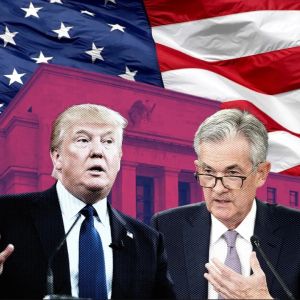
Federal Reserve Chair Jerome Powell is facing heat from President Donald Trump, who’s back in the White House and already tired of waiting for rate cuts. Trump’s frustration with Powell’s slow pace on easing interest rates has reached a point where he’s considering replacing him this summer. But despite the pressure, Powell still has most of his policy team on his side. According to a detailed report from the Wall Street Journal, while a couple of Trump’s own picks are now backing a July cut, most of the Fed’s twelve voting members still prefer holding steady. Inside the Fed, it’s not quiet. Tensions are building ahead of the July policy meeting, where the committee might be split down the middle. On one side, you have Michelle Bowman and Christopher Waller, both appointed by Trump, who say they’re open to cutting. On the other, a larger group, including all the key reserve bank presidents, are arguing there’s no rush. Bowman caught everyone off guard when she said she would support a rate cut in July. She was just named the Fed’s vice chair for supervision a few months ago and was one of the most hawkish members last year, even voting against a 0.5-point cut in September. That switch in tone came fast. Trump’s own appointees push back, but remain outnumbered Waller is also leaning toward a cut. He echoed Bowman’s view just last week, telling reporters he’s now open to loosening rates sooner than later. This dual push from both governors made traders nervous. Betting markets showed the odds of a July rate cut rose from 14% the week before to nearly 25% after Bowman’s comments. It looked like momentum was shifting, until the rest of the committee stepped in. John Williams, the New York Fed President, was the first to push back. He said the current target range of 4.25% to 4.5% is still “entirely appropriate,” and made it clear that the Fed should wait for more data before taking action. “We need to be vigilant in analyzing the totality of the data to see how conditions evolve,” he said. After Williams, other Fed presidents followed with the same message: don’t move too soon. Kevin Burgett, an analyst at LHMeyer, said flatly that “Waller and Bowman are definitely still outliers versus the committee as a whole.” That’s not just talk. If both Bowman and Waller vote for a cut next month and the rest of the committee doesn’t, it’ll be a rare moment. It’s been 32 years since two Washington-based Fed governors dissented in the same meeting. The divide is real. Matthew Luzzetti, chief economist at Deutsche Bank, said, “This is the most divided they’ve been in a good while.” The Fed’s internal projections make the disagreement even clearer. Of the voting members, ten support cutting rates two or three times before the year ends. Seven want to wait until 2026. The committee’s split is public now—and Trump is watching every move. He’s already pressuring Powell in public speeches and could name a new Fed chair soon. His options include any of the remaining six governors on the board, or an outsider when Adriana Kugler’s term ends in January. Tariff fears fuel more disagreement inside the Fed Trump’s loud demands for cheaper credit are clashing with warnings from economists inside the Fed. Powell, testifying before Congress this week, said the only reason rates haven’t already been cut is concern that new tariffs could trigger a new wave of inflation. Without those risks, the Fed might have acted already. Bowman and Waller argue there’s no real danger of that. Inflation has been dropping. Forecasts show that the Fed’s preferred inflation metric probably rose just 2.3% in the twelve months ending May, which is close enough to the 2% target. Waller thinks companies will absorb most of the tariff costs instead of passing them to shoppers. Bowman said the economy’s already slowing down and that means consumers won’t trigger another inflation spiral like the one seen in the early 2020s. But again, most Fed officials aren’t buying that. Williams pointed to a New York Fed survey showing that many businesses are passing all their tariff-related costs directly to consumers. Other economists believe companies may have front-loaded inventory before the tariffs hit, so the price impact just hasn’t shown up yet. With inflation memories still fresh, there’s concern that people are hyper-sensitive to even small price increases. That kind of panic can turn into real price pressure. Mary Daly, who runs the San Francisco Fed, also weighed in. She said that although she sees a path to lower rates later in the year, the risks of cutting now are too high. “I look more to the fall,” she told CNBC. Her voice adds to the majority who are saying: not yet. So, as July approaches, the Fed is walking a tightrope. Trump wants action. Bowman and Waller are nodding along. But Powell isn’t moving, at least not without more numbers. And the rest of the table is still on his side… for now. Cryptopolitan Academy: Tired of market swings? Learn how DeFi can help you build steady passive income. Register Now
